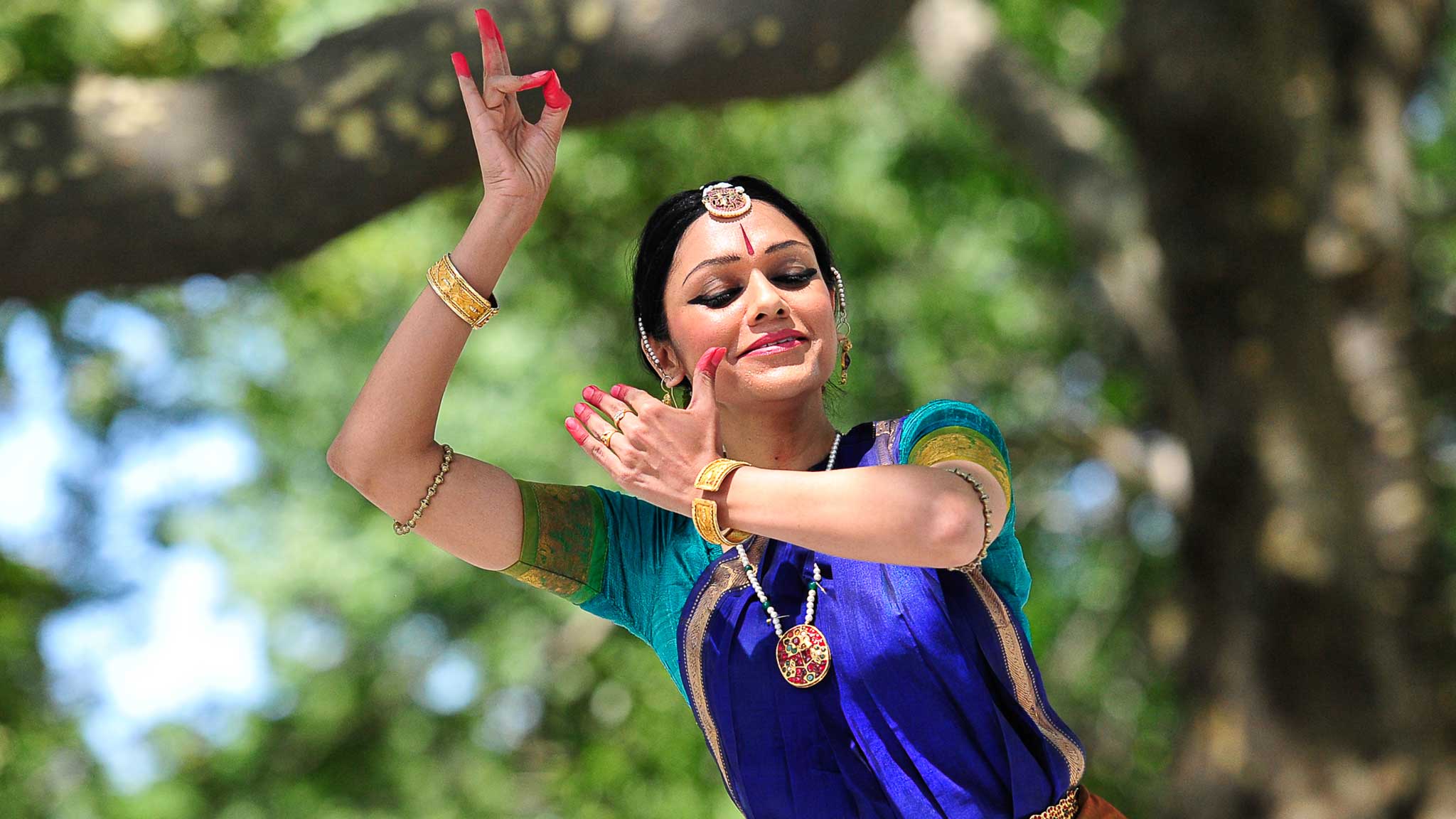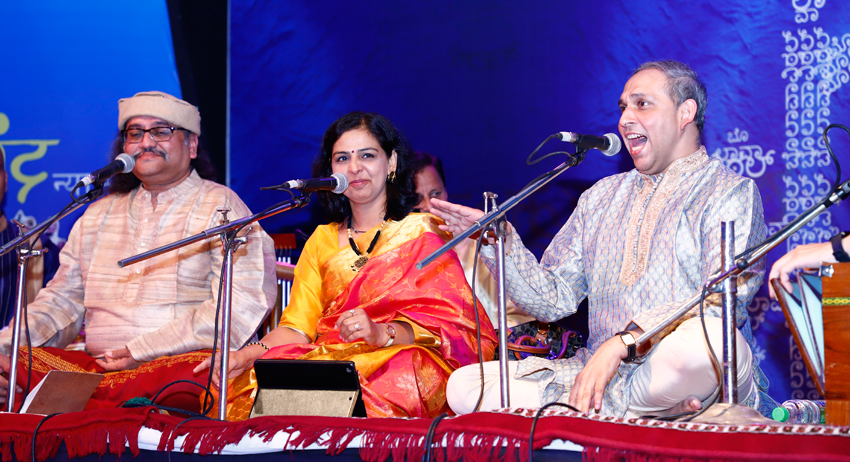Evam 2021 began with a scintillating production of Usha RK on day one and the second day brought to us the performance we were waiting for with bated breath. The current idol of Bharathanatyam, Guru Rama Vaidhyanathan, presented her ‘Now Margam’. ‘Now’ was connotated in two different ways. One interpretation suggested innovation and dealt with creatively changing the traditional structure of a composition to suit the present times. The Alarippu and Thillana of the evening came under this category. The second connotation referred to Rama Vaidhyanathan taking time to extensively work on rare traditional compositions in the recent past. The Varnam and Padam were the compositions she had worked on.
The performance began with what we can term as Vaidhyanathan’s signature dance- the Mayur Alarippu. Precisely composed in a cycle of 5 and a half beats by late Karaikudi Shivakumar, this Alarippu is brought to life by movement dynamics used to depict the grace and beauty of the peacock. There was a beautiful juxtaposition of sharp and graceful movements which undoubtedly showcased the bird’s qualities in all its glory.

Varnam– the pièce de résistance of this recital was indeed a work of art. A rare composition of Shyama Sastry, ‘Saami nee rammannave’ in Ananda Bhairavi ragam and Ata talam was flavoured with so much depth that viewers didn’t feel the loss of a live performance set up in an auditorium for even a minute. Both Vaidhyanathan and the vocalist of the evening, Sudha Raghuraman spent a lot of time brewing in this composition and the result of this sadhana was inexplicable. The Trikala jathi composed by Dr. S Vasudevan set up a firm base on which the nayika would be deciphered. Here, she is a devotee of Vishnu in the form of Varadaraja Swamy of Kancheepuram and yearns to be with him. She persuades her Sakhi to bring him to her.
Close up shots of the nayika trying to utter her Swamy’s name, the various depictions of slowed and passing time, the nectar-filled flowers that adorn Manmatha’s arrows, the showering of these very arrows in countless succession- all accompanied by Sudha Raghuraman’s incomparable pull and give of the ragam’s swaras created a heady experience! In the charanam the nayika established the incessant showering of Kamadeva’s arrows with intelligent interspersing of rhythm and lyric, which created apt effect for the concept conveyed. This paved the perfect way for her to challenge him to find a single place on her body to strike just one more arrow. The nayika’s sheer grit that lay beneath all that hopelessness was a palpable feeling, even through the digital medium.
The levels of persuasiveness increased ever so slightly in every single line of the Varnam, a feat that only an artiste of Vaidhyanathan’s calibre can do. “Bring Him; time is precious, go and bring him; Kamadeva has brought these emotions in me and everything around me seems to be connected with the God of Love, bring him; I want to see him; I can’t possibly take it anymore, bring him”, is the storyline of most Varnams. It is the melange of the singing and dancing that breathes new life into it; that lifts it beyond the literal. Here, both the song and dance complemented each other and enhanced the other’s rendition. The crisp jathis by Sumodh Sreedaran were the perfectly timed, short bursts of nritta needed between the intense abhinaya that viewers didn’t want to end.
A full costume change (which wouldn’t have been possible in a traditional live presentation) brought with it a rare Kshetrayya Padam which broadly depicted the Swadheenapathika nayika– the heroine who is confident of her Lord’s love for her. Sudha Raghuraman set the Padam in Dharmavathi Ragam and Mishrachapu talam. Rama Vaidhyanathan’s presentations have always been replete with relevance to the present times and relatability for all age groups. It thus came as no surprise that she would pick a composition which had layered meanings that covered lost opportunities, dishevelled plans and discontentment, which have been the norm of the past year. She began by saying, “life will always have its ups and downs, but as long as we have the larger picture in our vision, we will have the fortitude to face both with equal zeal.” The Nayika in this Padam showcases this by telling her friend to take a message to Lord Muvvagopala, which says, “The positives and negatives are in his hands. I will wholeheartedly accept both.”
‘Tharuniro punya paapamu tana chetidi’ was a treat, especially focusing on the wordplay of ‘punya paapamu’– which laid the foundation for myriad contrasting situations to unfold before us. Vaidhyanathan presented to us a meaningful sentiment, “When we are the cows herded by Him, when we are the puppets held up by Him, how can we not accept all the trials along with the joys the He has given us?”
Select verses from the famous Skanda Sasti Kavacham by Devaraya Swamigal were musically adapted into a Tillana format by Sudha Raghuraman. The Skanda Sasti Tillana was replete was extreme devotion and undiluted joy. As the dancer and music ensemble lost themselves in the higher realms of art, viewers were left feeling privileged to have been able to feel that divine bhakti, ever so powerfully from within the comfort of our homes. The ‘Now margam’ indeed elicited from all rasikas a lot to take with us and reflect on.
[adrotate group=”9″]
Rama Vaidhyanathan was supported by a fantastic music ensemble and it was evident that they were not just the support, but an active part of the production. It is beyond doubt that the ultimate result could only be possible with the involvement of an orchestra for more than just a couple of rehearsals with the dancer. The show was uplifted by Sudha Raghuraman, whose singing prowess would need a separate report; by Dr. S. Vasudevan, who perfectly wielding the nattuvangam and held the score together; by Manohar Balatchandirane, who never played a single unnecessary beat and was so in tune with the dancer’s hands and feet that the perfect synchrony that resulted was brilliant; and by flautist G Raghuraman, whose lilting melody transported us through the various moods of the dance presented effortlessly.
About Contributor- Shilpa Nanjappa is a Bharatanatyam soloist and a disciple of Guru Padmini Ramachandran.










